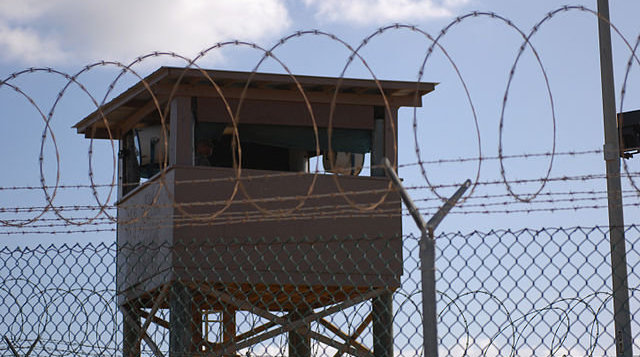
President Donald Trump’s administration plans to increase the number of undocumented migrants being transferred to the US Naval facility at Guantánamo Bay, Cuba, according to government documents obtained by Politico and the Washington Post. The documents, reported by the media outlets June 10, state that 9,000 undocumented immigrants are currently being vetted for transfer to Guantánamo, with the first transfers to begin as soon as later this week.
The Migrant Operations Center at the Naval Station Guantánamo Bay was originally opened in 1991 to hold Haitian migrants, and predates the detention camp established at the base after the events of 9-11 to hold “illegal enemy combatants.” Guantánamo gained a grim reputation during the years it was heavily used to hold “enemy combatants” after 9-11, becoming known for what rights groups called extralegal and inhumane conditions. Since then, especially through efforts under the administrations of presidents Barack Obama and Joe Biden, the number of detainees held there has dwindled to 15.
The new plan for the Migrant Operations Center comes amid the Trump administration’s harsh crackdown on undocumented immigrants living in the US. This will be the first mass-deportation to Guantánamo since Trump signed an executive order on his first days in office ordering the secretary of defense and the secretary of homeland security to expand the Migrant Operations Center at Guantanamo to full capacity. The center can hold up to 30,000 detainees. Trump’s executive order and the newly released documents indicate that the facility will be used to hold undocumented migrants temporarily until they are transferred to their countries of origin.
Politico and the Washington Post reported that this plan has only come together in the last few days, and may be subject to change. Also at issue is a class-action lawsuit pending in Washington DC, Luna Gutierrez v. Noem, in which civil rights groups are calling for the courts to declare holding immigrants at Guantánamo illegal and unconstitutional. The lawsuit cites 10 immigrant detainees who experienced conditions such as insufficient food and rodent infestations at Guantánamo Bay.
From JURIST, June 11. Used with permission.
Photo: Spc. Cody Black/WikiMedia via Jurist





HRW: halt further transfers to Gitmo migrant detention center
Human Rights Watch (HRW) on Aug. 29 strongly urged the US to immediately stop transferring immigrant detainees to the Guantánamo Bay Naval Base in Cuba, warning that they face “abusive and inhumane detention conditions” that may amount to ill-treatment.
According to interviews conducted by HRW with migrants formerly held at the facility, US officials did not inform them that they were being taken to Guantánamo. They reported that they were kept incommunicado in unsanitary conditions, with no explanation of their legal status, and without any notification to their families. Juanita Goebertus, Americas director at Human Rights Watch, said: “The US government has taken immigrants to Guantánamo and subjected them to incommunicado detention in appalling conditions… No immigrant or asylum seeker who leaves their country in search of protection should be taken to a place like this.”
In late January 2025, President Donald Trump signed a memorandum to expand the Migrants Operations Center (GMOC) at Guantánamo, aiming to house up to 30,000 immigrants deemed the “worst criminal illegal aliens.” Amnesty International condemnedthe plan, citing Guantánamo’s notoriety for human rights abuses.
In February 2025, nearly 200 Venezuelan migrants were transported to Guantánamo Bay. Court documents indicate that 127 were held in a high-security area (Camp 6), while 51 were placed in low-security tent facilities. The majority, 177 of the nearly 200 detainees, were deported to Venezuela after being flown to Honduras.
Several civil rights lawsuits challenged the transfers to Guantánamo. In March 2025, the ACLU (American Civil Liberties Union), CCR (Center for Constitutional Rights), and IRAP (International Refugee Assistance Project) filed Espinoza Escalona v. Noem to block further transfers and secure legal access for detainees. A second case, Gutierrez v. Noem followed in June 2025.
According to Amnesty International, “Guantánamo Bay detention centre is a symbol of torture, rendition and indefinite detention without charge or trial.” Amid the post-9/11 “war on terror,” the facility was used to hold people perceived to be “enemy combatants”—intentionally chosen as an offshore location where US legal protections do not apply. In its report entitled “Guantánamo Bay: decades of injustice,” Amnesty said: “The facilities at Guantánamo have become emblematic of the gross human rights abuses and torture perpetrated by the US government in the name of counterterrorism.”
International law, including the 1951 Refugee Convention, its 1967 Protocol, as well as the principle of non-refoulement, prohibit returning individuals to territories where their safety or freedom may be at risk. While the US has legal frameworks like the Immigration and Nationality Act (INA) granting asylum protections, HRW argues that these standards have been severely compromised by opaque procedures and extraterritorial detention at Guantánamo.
HRW is calling on the US government to halt all current and future transfers of migrants to Guantánamo, ensure detainees in Guantánamo receive due process and meaningful access to legal counsel, and respect international human rights norms obligating transparency and protection of asylum seekers. (Jurist)